Many junior SEOs make the same mistake: they chase high search volume, assuming it means long-term opportunity. But search volume alone is completely misleading.
A keyword with 50,000 searches/month sounds like a goldmine, until you realize it’s already in decline. Investing in a fading trend is like buying MySpace stock today.
Every keyword follows a lifecycle moving through these distinct phases:
- Intro stage – Early interest, but not mainstream yet
- Surge & peak – Explosive growth and peak visibility
- Sustained growth – Long-term, steady momentum
- Plateau – Growth levels off, demand stabilizes
- Resurgence / seasonality – Demand spikes again, either cyclically or unexpectedly
- Decline – Gradual loss of interest over time
- Niche survival or extinction – Either a small, steady demand remains, or the keyword disappears entirely
If you don’t know where a keyword is in this cycle, you’re flying blind.
This post breaks down each phase, the patterns behind them, and how to spot emerging opportunities before your competitors do.
Let’s dig in.
search demand is still low, but early adopters are starting to take interest.
At this stage, a topic’s future is uncertain.
It might gain traction and surge in popularity, or it might fizzle out before reaching mainstream awareness. The key is identifying which trends have real potential.
Here’s what to look out for:
Pre-peak growth – An exponential increase in search interest before reaching a tipping point.
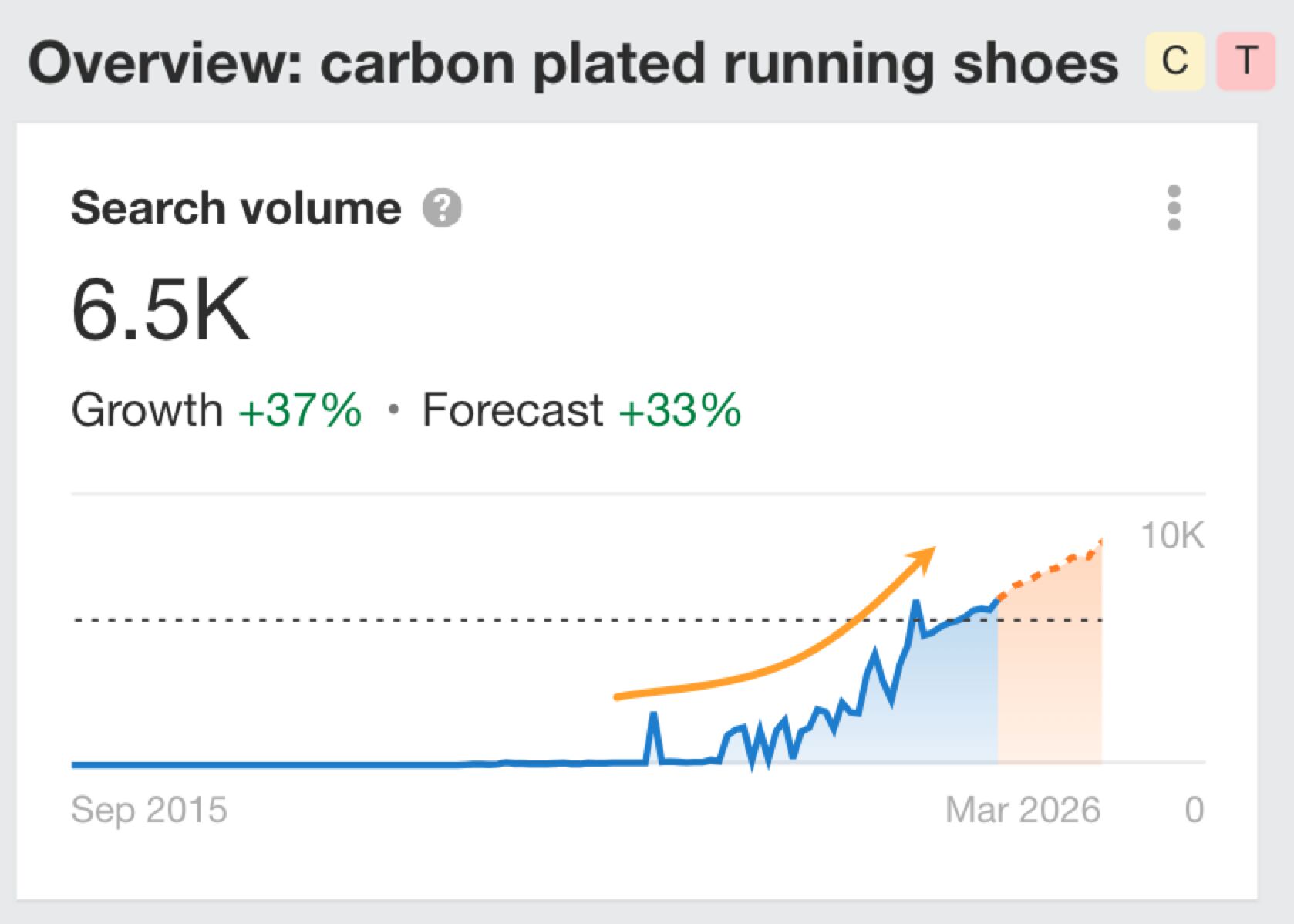
Steady growth – A slow but consistent upward trajectory.
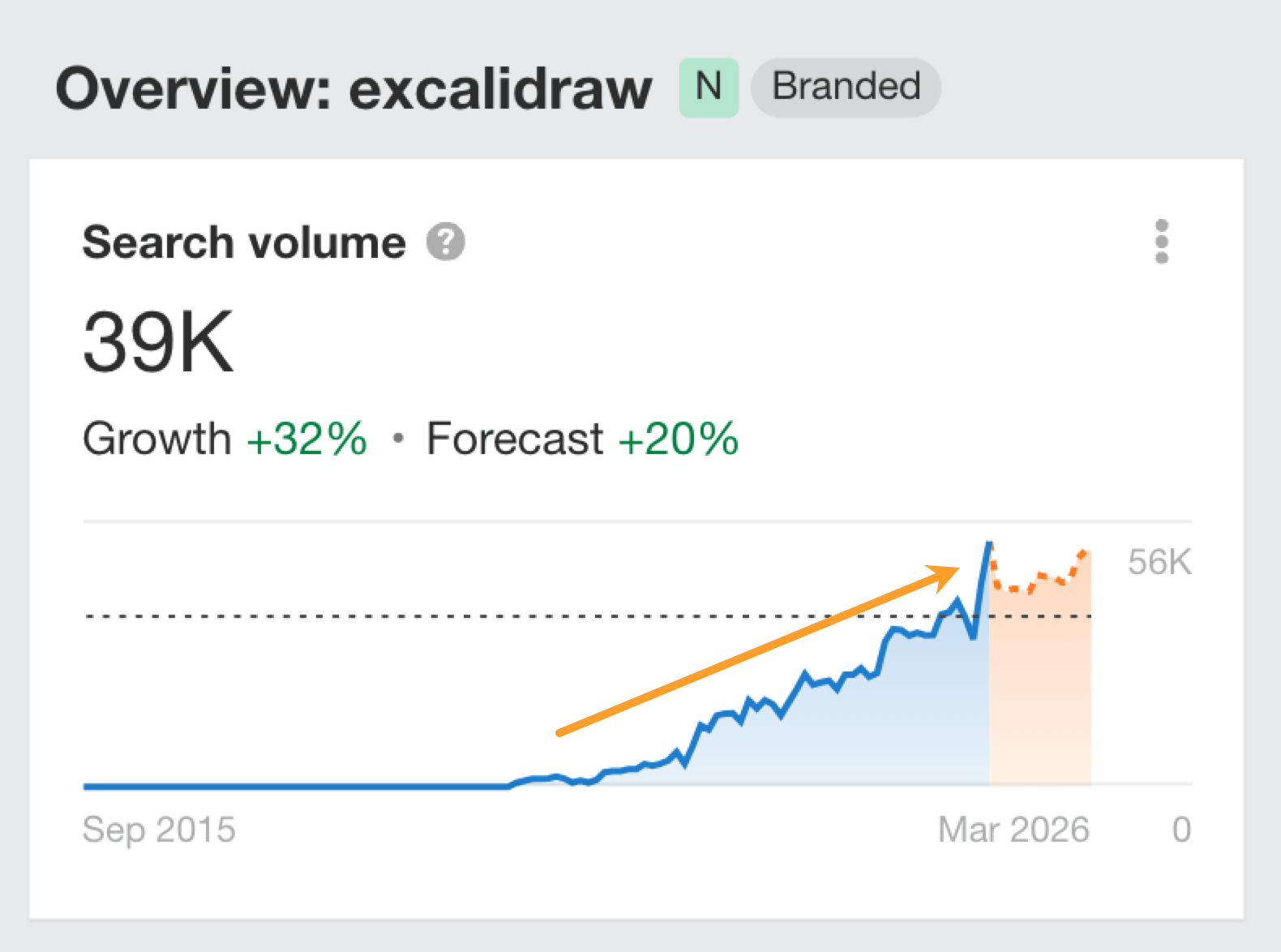
Early virality / launch-related growth – A steep incline due to a product launch, social media trend, or PR push.
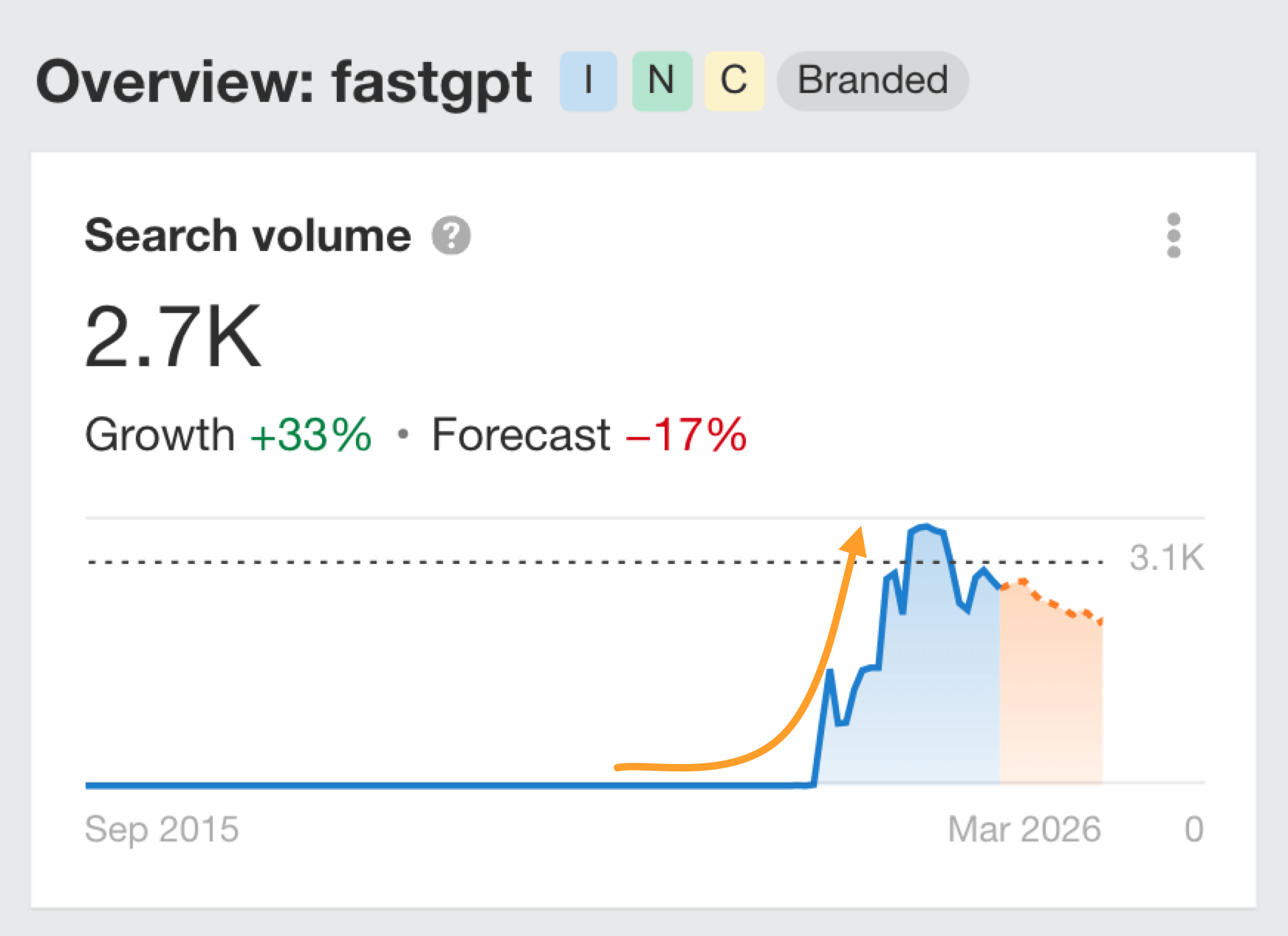
Keywords in this stage can stay under the radar for months or even years. Some take off quickly, while others require sustained marketing or a major industry shift to gain momentum.
SEO strategy for the intro stage
- Look beyond search volume – Topics in this stage have low search volume and require a leap of faith, trusting intuition, and real-world trends over keyword data, but their potential lies in early adoption.
- Monitor industry signals – Pay attention to product launches, investor funding, and expert discussions that hint at future demand.
- Create foundational content early – Publishing now can establish authority before competition floods in.
Many breakout trends start unnoticed. The best SEOs don’t wait until a keyword is trending, they invest before the surge begins.
optimize existing content that can likely rank quickly, allowing you to capture traffic while demand is high.
Evaluate long-term potential – Not every spike is worth chasing. Hype-driven trends fade fast. A short-lived search trend may only spike for a handful of months, whereas a topic that grows over 12+ months has greater long-term longevity.
Plan for post-peak shifts – Many keywords evolve after their peak. Look for ways to pivot content toward related evergreen topics to maintain relevance.
Riding a surge successfully requires speed and strategy. The best SEOs know when to capitalize on a trend and when to avoid short-lived fads that won’t hold long-term value.
build website authority and own the topic before competitors catch on.
Here’s what to look out for:
Peaking growth – A keyword has surged but is still increasing, though at a slower pace than before.
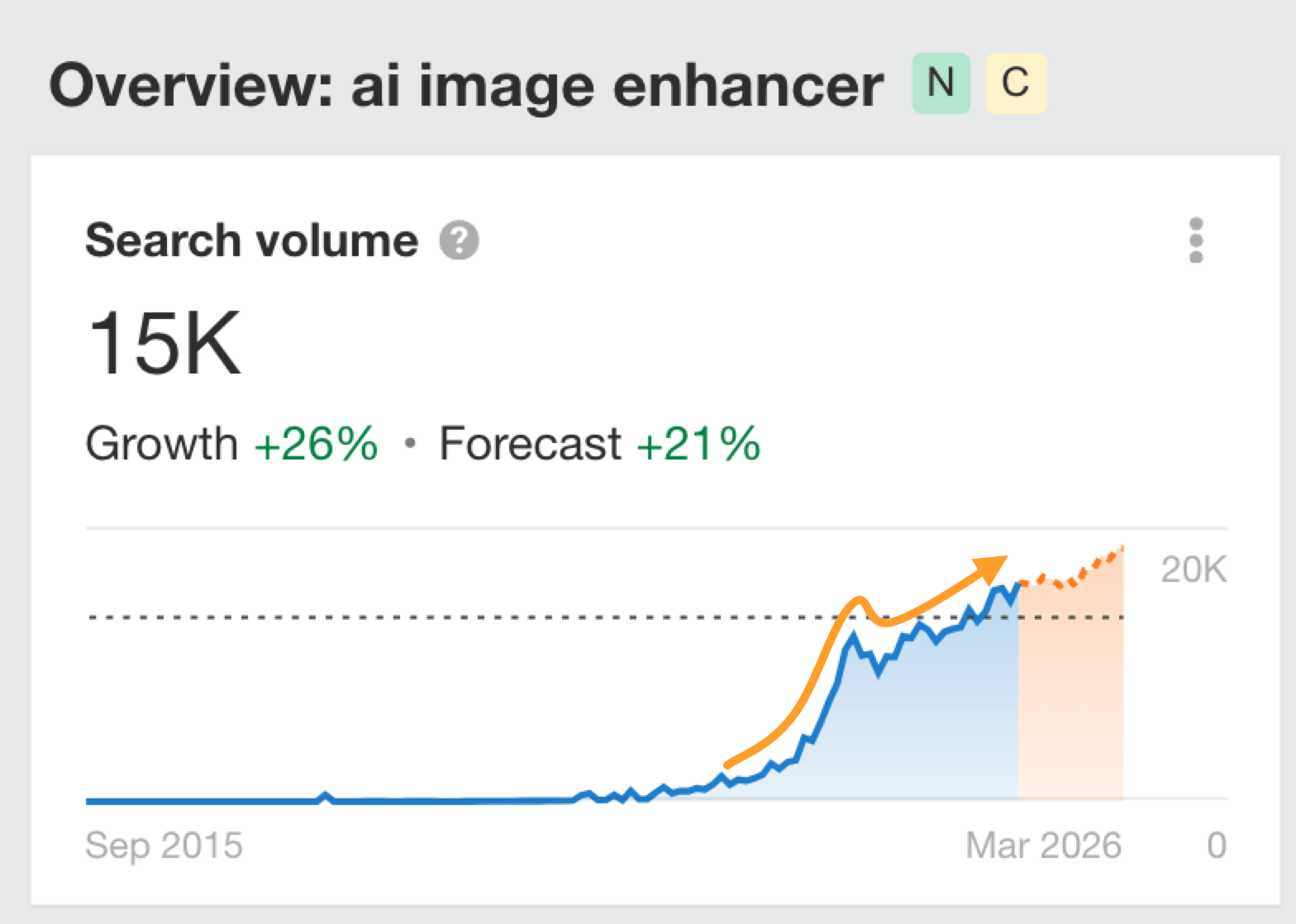
Gradual growth – A keyword experiences a steady upward trend with minor fluctuations.
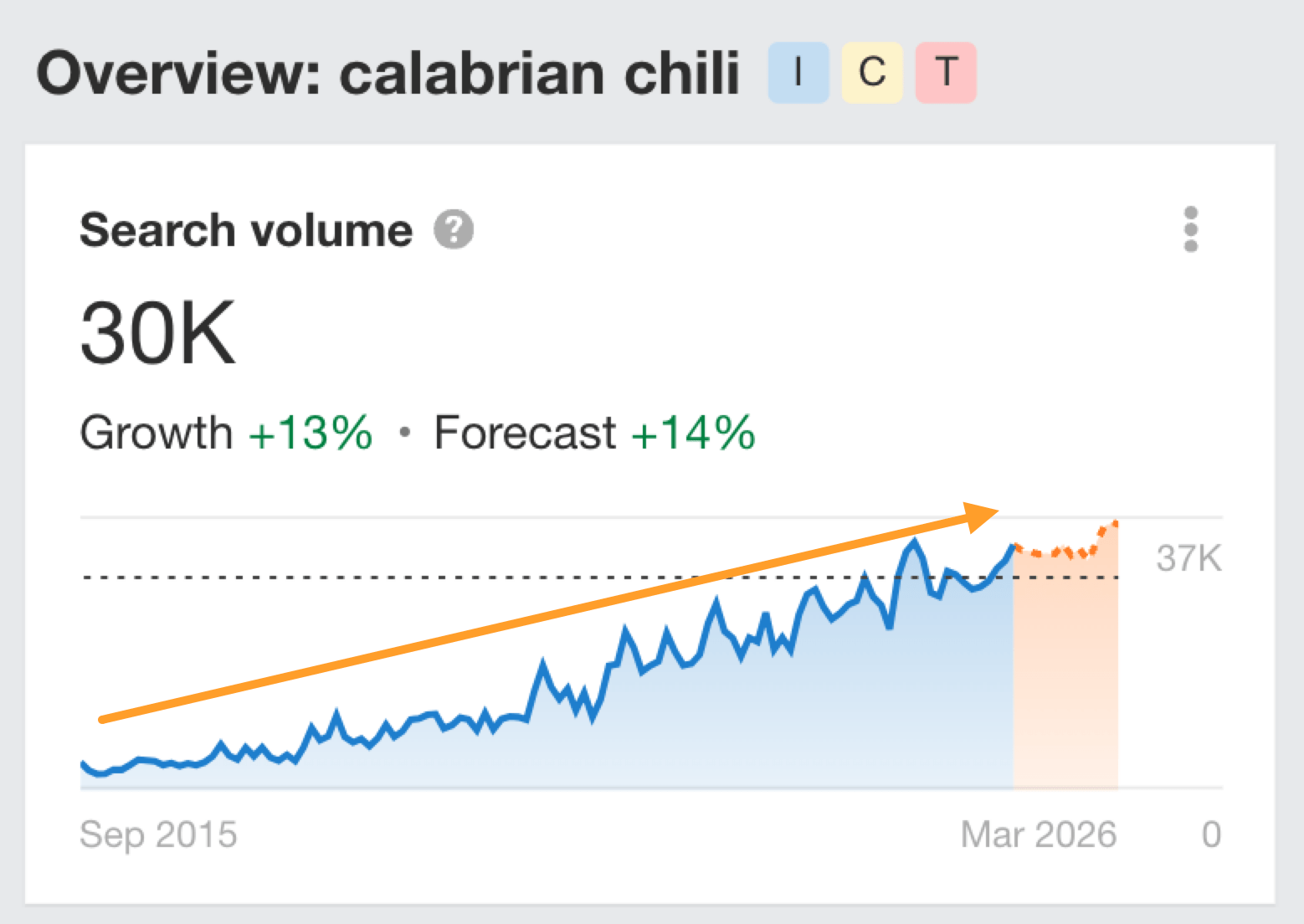
Post-peak growth – After an initial peak, the keyword starts stabilizing at a higher level than before the peak.
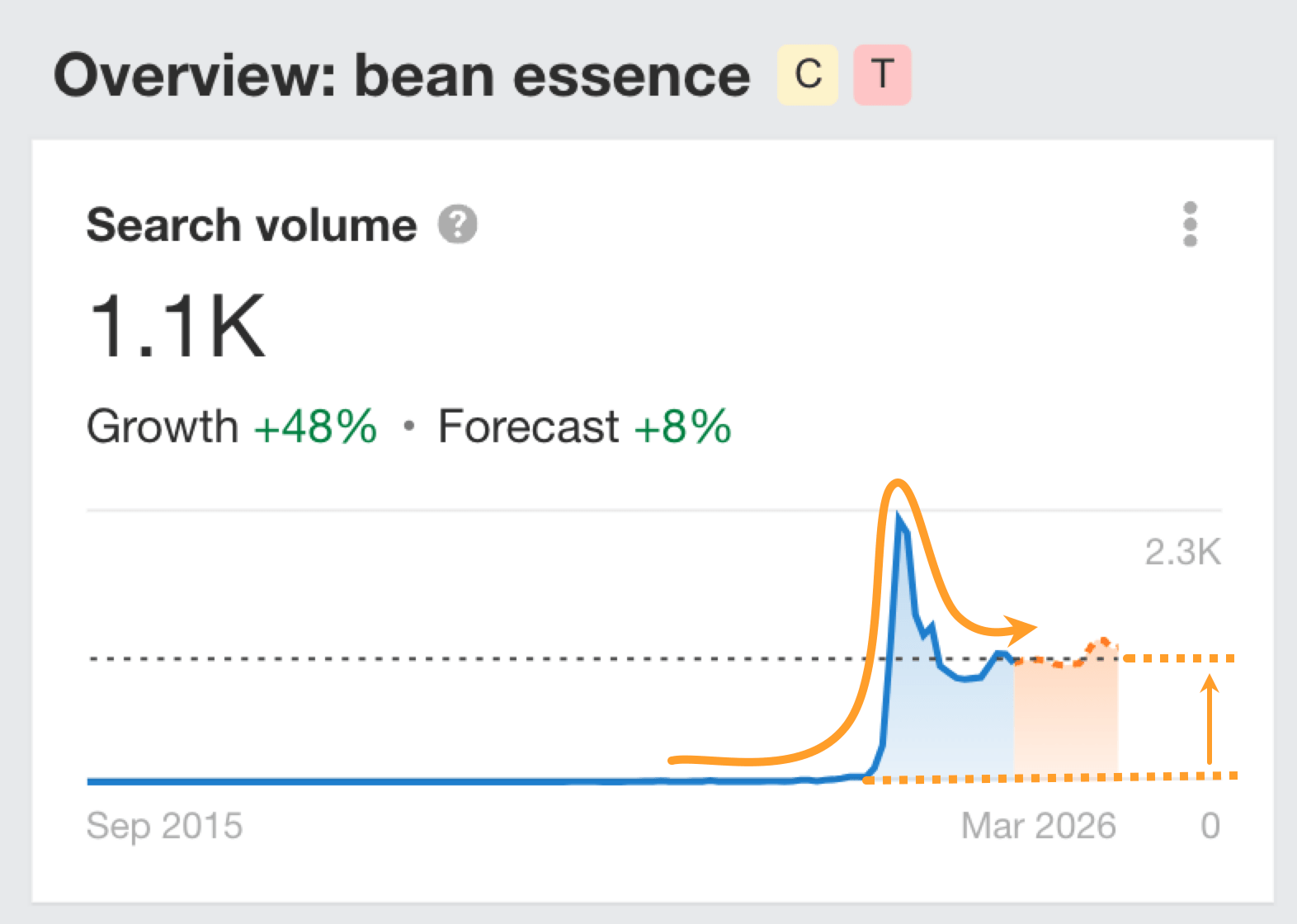
Topics in this phase have already proven their demand and are less likely to decline suddenly. The longer a keyword maintains steady growth, the more likely it is to become an evergreen topic.
However, not all topics with sustained growth remain strong forever. Understanding their trajectory is key to making the right content and optimization decisions.
SEO strategy for sustained growth
- Double down on authority – These keywords have long-lasting value. Invest in pillar content, supporting pages, and ongoing optimization to secure rankings.
- Monitor shifts in demand – Some keywords maintain slow growth indefinitely, while others may begin plateauing. Keep an eye on changes in search demand, intent, and competition.
- Consider content expansion – If a keyword has proven staying power, explore related subtopics to increase visibility and topic coverage.
Long-term growth topics compound in value over time. SEOs who invest in them early and consistently can build strong, defensible rankings that drive sustained traffic.
holiday-related searches that peak at the same time every year. Others are driven by unpredictable external events, making them harder to plan for but valuable when spotted early.
SEO strategy for resurgence & seasonality
- Use seasonal trends – If a topic surges predictably, create seasonal content refreshes and promotional campaigns ahead of time.
- Monitor news and social media – Unexpected resurgences are often driven by viral moments. Being first to react can capture huge search interest and visibility in Google News or Discover.
- Align link building with surges – If a topic has predictable peaks or is actively resurging, it’s a great time to build links and ride the topic’s popularity in the moment.
Resurgence and seasonality create huge opportunities for traffic if you know when to act. The best SEOs anticipate demand before it happens and position their content accordingly.
Keywords Explorer and navigate to the Overview tab.
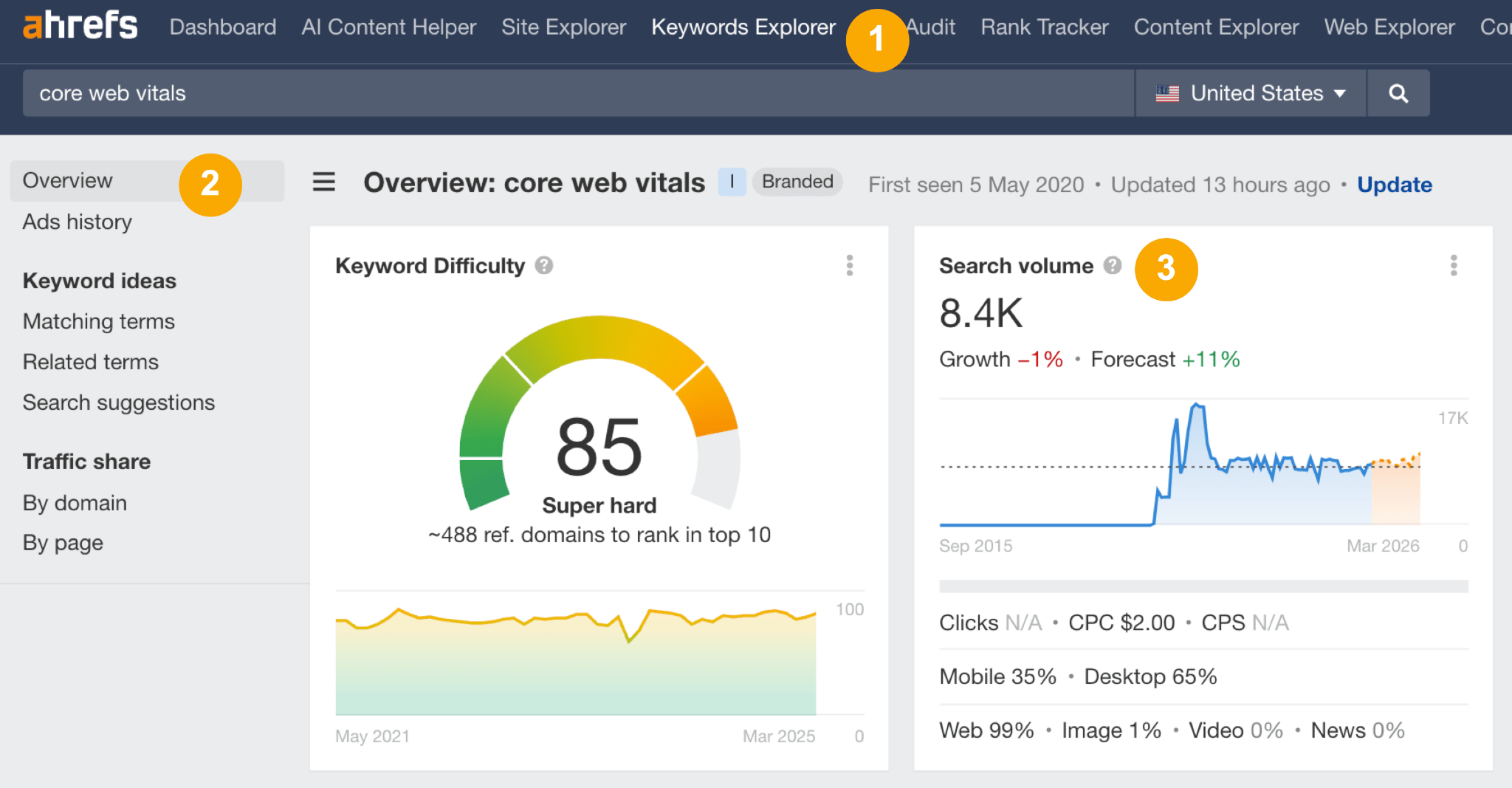
That’s where all the above screenshots have been taken from. It shows you the keyword’s demand history and demand forecast for upcoming months.
For a larger group of keywords, you can instead use the growth filters in the Matching Terms report:
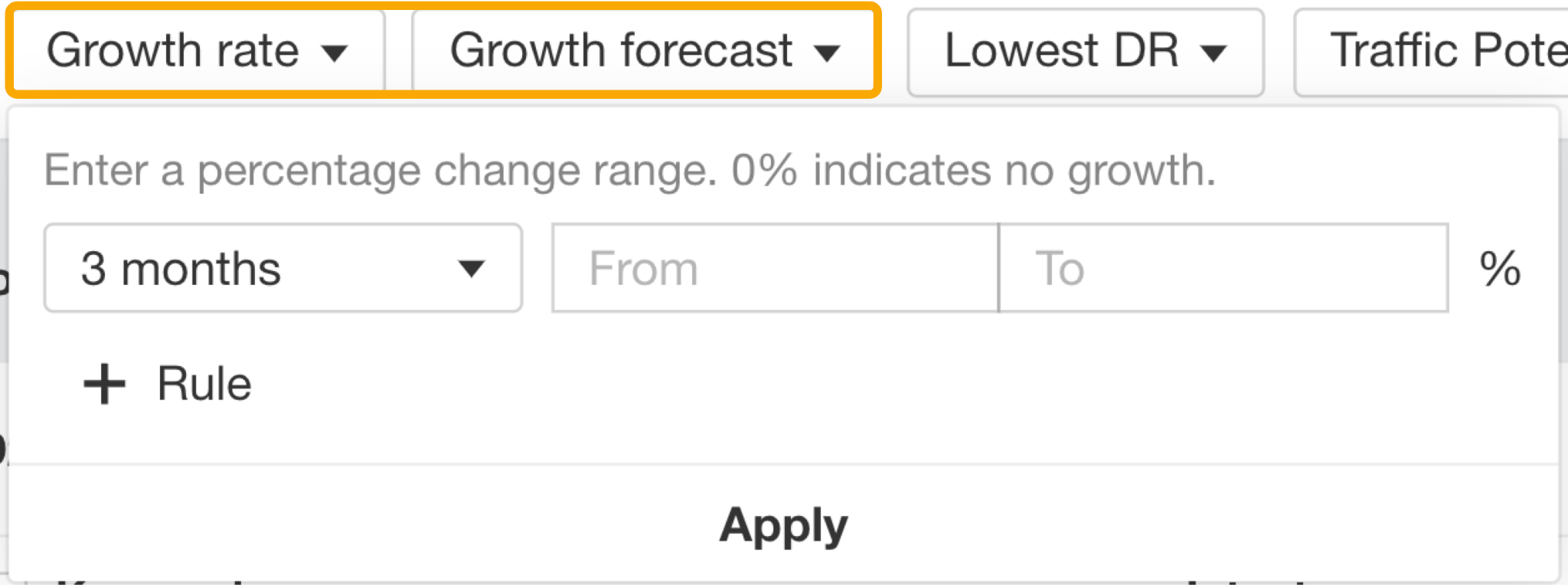
With the Growth Rate filter, you can remove keywords that might be declining or exhibiting high-risk signals you don’t want to target in the long term.
With the Growth Forecast filter, you can identify keywords that will continue trending and growing.
Final thoughts
Search demand isn’t static; it moves through predictable phases. SEOs who track these shifts can spot rising trends early, avoid wasting resources on fading topics, and invest in content that will drive long-term results.
Most SEO specialists only look at search volume today, but the real winners in SEO think about where demand is going next.
To stay ahead, always ask yourself: is this topic growing, peaking, plateauing, or fading? The future of your SEO strategy depends on it.
Similar Posts

Tangem Pay, Crypto Scams & Final Day of Sale (LIVE AMA)
Buy 1 Tangem Wallet Get 1 60% off using my link: https://cyberscrilla.short.gy/lastday Tangem wallet user guide: https://youtu.be/9igpzsN8ldY?si=8yLmZ_auBUPrO6GZ…
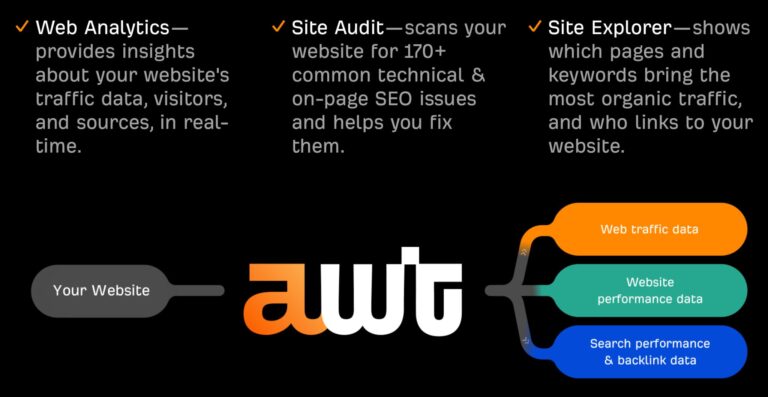
How to Track Website Metrics With One Free, Privacy-Friendly Tool
There are plenty of website metrics out there, and just as many tools to track them. So, to…

If You Missed it… Tangem’s Deal Ends Today
Tangem Wallet 30% off deal: https://tangem.com/en/pricing/?promocode=CYBERSCRILLA&promocode=BF2025 User guide: https://youtu.be/9igpzsN8ldY?si=gXf_Ub-Ae_l_nUaC

URGENT: New Malware Targeting All Crypto Wallets! (LIVE)
Ledger Wallets – (Get up to $80 in FREE Bitcoin): https://shop.ledger.com/pages/september25-value-offer/?r=f3f59e340ecb Link to article: https://jdstaerk.substack.com/p/we-just-found-malicious-code-in-the
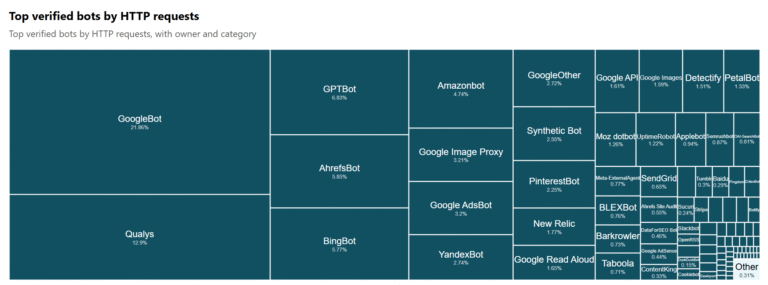
The SEO Bots That ~140 Million Websites Block the Most
Ever wonder which SEO bots are the most blocked? This can impact the quality of the data…

Your Guide to Success: How to Start Dropshipping
If you’re looking to start an online business and don’t want to deal with managing inventory, product…
At this stage, a topic’s future is uncertain.
It might gain traction and surge in popularity, or it might fizzle out before reaching mainstream awareness. The key is identifying which trends have real potential.
Here’s what to look out for:
Pre-peak growth – An exponential increase in search interest before reaching a tipping point.

Steady growth – A slow but consistent upward trajectory.

Early virality / launch-related growth – A steep incline due to a product launch, social media trend, or PR push.

Keywords in this stage can stay under the radar for months or even years. Some take off quickly, while others require sustained marketing or a major industry shift to gain momentum.
SEO strategy for the intro stage
- Look beyond search volume – Topics in this stage have low search volume and require a leap of faith, trusting intuition, and real-world trends over keyword data, but their potential lies in early adoption.
- Monitor industry signals – Pay attention to product launches, investor funding, and expert discussions that hint at future demand.
- Create foundational content early – Publishing now can establish authority before competition floods in.
Many breakout trends start unnoticed. The best SEOs don’t wait until a keyword is trending, they invest before the surge begins.
optimize existing content that can likely rank quickly, allowing you to capture traffic while demand is high.
Evaluate long-term potential – Not every spike is worth chasing. Hype-driven trends fade fast. A short-lived search trend may only spike for a handful of months, whereas a topic that grows over 12+ months has greater long-term longevity.
Plan for post-peak shifts – Many keywords evolve after their peak. Look for ways to pivot content toward related evergreen topics to maintain relevance.
Riding a surge successfully requires speed and strategy. The best SEOs know when to capitalize on a trend and when to avoid short-lived fads that won’t hold long-term value.
build website authority and own the topic before competitors catch on.
Here’s what to look out for:
Peaking growth – A keyword has surged but is still increasing, though at a slower pace than before.

Gradual growth – A keyword experiences a steady upward trend with minor fluctuations.

Post-peak growth – After an initial peak, the keyword starts stabilizing at a higher level than before the peak.

Topics in this phase have already proven their demand and are less likely to decline suddenly. The longer a keyword maintains steady growth, the more likely it is to become an evergreen topic.
However, not all topics with sustained growth remain strong forever. Understanding their trajectory is key to making the right content and optimization decisions.
SEO strategy for sustained growth
- Double down on authority – These keywords have long-lasting value. Invest in pillar content, supporting pages, and ongoing optimization to secure rankings.
- Monitor shifts in demand – Some keywords maintain slow growth indefinitely, while others may begin plateauing. Keep an eye on changes in search demand, intent, and competition.
- Consider content expansion – If a keyword has proven staying power, explore related subtopics to increase visibility and topic coverage.
Long-term growth topics compound in value over time. SEOs who invest in them early and consistently can build strong, defensible rankings that drive sustained traffic.
holiday-related searches that peak at the same time every year. Others are driven by unpredictable external events, making them harder to plan for but valuable when spotted early.
SEO strategy for resurgence & seasonality
- Use seasonal trends – If a topic surges predictably, create seasonal content refreshes and promotional campaigns ahead of time.
- Monitor news and social media – Unexpected resurgences are often driven by viral moments. Being first to react can capture huge search interest and visibility in Google News or Discover.
- Align link building with surges – If a topic has predictable peaks or is actively resurging, it’s a great time to build links and ride the topic’s popularity in the moment.
Resurgence and seasonality create huge opportunities for traffic if you know when to act. The best SEOs anticipate demand before it happens and position their content accordingly.
Keywords Explorer and navigate to the Overview tab.

That’s where all the above screenshots have been taken from. It shows you the keyword’s demand history and demand forecast for upcoming months.
For a larger group of keywords, you can instead use the growth filters in the Matching Terms report:

With the Growth Rate filter, you can remove keywords that might be declining or exhibiting high-risk signals you don’t want to target in the long term.
With the Growth Forecast filter, you can identify keywords that will continue trending and growing.
Final thoughts
Search demand isn’t static; it moves through predictable phases. SEOs who track these shifts can spot rising trends early, avoid wasting resources on fading topics, and invest in content that will drive long-term results.
Most SEO specialists only look at search volume today, but the real winners in SEO think about where demand is going next.
To stay ahead, always ask yourself: is this topic growing, peaking, plateauing, or fading? The future of your SEO strategy depends on it.
Similar Posts

Tangem Pay, Crypto Scams & Final Day of Sale (LIVE AMA)
Buy 1 Tangem Wallet Get 1 60% off using my link: https://cyberscrilla.short.gy/lastday Tangem wallet user guide: https://youtu.be/9igpzsN8ldY?si=8yLmZ_auBUPrO6GZ…

How to Track Website Metrics With One Free, Privacy-Friendly Tool
There are plenty of website metrics out there, and just as many tools to track them. So, to…

If You Missed it… Tangem’s Deal Ends Today
Tangem Wallet 30% off deal: https://tangem.com/en/pricing/?promocode=CYBERSCRILLA&promocode=BF2025 User guide: https://youtu.be/9igpzsN8ldY?si=gXf_Ub-Ae_l_nUaC

URGENT: New Malware Targeting All Crypto Wallets! (LIVE)
Ledger Wallets – (Get up to $80 in FREE Bitcoin): https://shop.ledger.com/pages/september25-value-offer/?r=f3f59e340ecb Link to article: https://jdstaerk.substack.com/p/we-just-found-malicious-code-in-the

The SEO Bots That ~140 Million Websites Block the Most
Ever wonder which SEO bots are the most blocked? This can impact the quality of the data…

Your Guide to Success: How to Start Dropshipping
If you’re looking to start an online business and don’t want to deal with managing inventory, product…
Riding a surge successfully requires speed and strategy. The best SEOs know when to capitalize on a trend and when to avoid short-lived fads that won’t hold long-term value.
build website authority and own the topic before competitors catch on.
Here’s what to look out for:
Peaking growth – A keyword has surged but is still increasing, though at a slower pace than before.

Gradual growth – A keyword experiences a steady upward trend with minor fluctuations.

Post-peak growth – After an initial peak, the keyword starts stabilizing at a higher level than before the peak.

Topics in this phase have already proven their demand and are less likely to decline suddenly. The longer a keyword maintains steady growth, the more likely it is to become an evergreen topic.
However, not all topics with sustained growth remain strong forever. Understanding their trajectory is key to making the right content and optimization decisions.
SEO strategy for sustained growth
- Double down on authority – These keywords have long-lasting value. Invest in pillar content, supporting pages, and ongoing optimization to secure rankings.
- Monitor shifts in demand – Some keywords maintain slow growth indefinitely, while others may begin plateauing. Keep an eye on changes in search demand, intent, and competition.
- Consider content expansion – If a keyword has proven staying power, explore related subtopics to increase visibility and topic coverage.
Long-term growth topics compound in value over time. SEOs who invest in them early and consistently can build strong, defensible rankings that drive sustained traffic.
holiday-related searches that peak at the same time every year. Others are driven by unpredictable external events, making them harder to plan for but valuable when spotted early.
SEO strategy for resurgence & seasonality
- Use seasonal trends – If a topic surges predictably, create seasonal content refreshes and promotional campaigns ahead of time.
- Monitor news and social media – Unexpected resurgences are often driven by viral moments. Being first to react can capture huge search interest and visibility in Google News or Discover.
- Align link building with surges – If a topic has predictable peaks or is actively resurging, it’s a great time to build links and ride the topic’s popularity in the moment.
Resurgence and seasonality create huge opportunities for traffic if you know when to act. The best SEOs anticipate demand before it happens and position their content accordingly.
Keywords Explorer and navigate to the Overview tab.

That’s where all the above screenshots have been taken from. It shows you the keyword’s demand history and demand forecast for upcoming months.
For a larger group of keywords, you can instead use the growth filters in the Matching Terms report:

With the Growth Rate filter, you can remove keywords that might be declining or exhibiting high-risk signals you don’t want to target in the long term.
With the Growth Forecast filter, you can identify keywords that will continue trending and growing.
Final thoughts
Search demand isn’t static; it moves through predictable phases. SEOs who track these shifts can spot rising trends early, avoid wasting resources on fading topics, and invest in content that will drive long-term results.
Most SEO specialists only look at search volume today, but the real winners in SEO think about where demand is going next.
To stay ahead, always ask yourself: is this topic growing, peaking, plateauing, or fading? The future of your SEO strategy depends on it.
Similar Posts

Tangem Pay, Crypto Scams & Final Day of Sale (LIVE AMA)
Buy 1 Tangem Wallet Get 1 60% off using my link: https://cyberscrilla.short.gy/lastday Tangem wallet user guide: https://youtu.be/9igpzsN8ldY?si=8yLmZ_auBUPrO6GZ…

How to Track Website Metrics With One Free, Privacy-Friendly Tool
There are plenty of website metrics out there, and just as many tools to track them. So, to…

If You Missed it… Tangem’s Deal Ends Today
Tangem Wallet 30% off deal: https://tangem.com/en/pricing/?promocode=CYBERSCRILLA&promocode=BF2025 User guide: https://youtu.be/9igpzsN8ldY?si=gXf_Ub-Ae_l_nUaC

URGENT: New Malware Targeting All Crypto Wallets! (LIVE)
Ledger Wallets – (Get up to $80 in FREE Bitcoin): https://shop.ledger.com/pages/september25-value-offer/?r=f3f59e340ecb Link to article: https://jdstaerk.substack.com/p/we-just-found-malicious-code-in-the

The SEO Bots That ~140 Million Websites Block the Most
Ever wonder which SEO bots are the most blocked? This can impact the quality of the data…

Your Guide to Success: How to Start Dropshipping
If you’re looking to start an online business and don’t want to deal with managing inventory, product…
Here’s what to look out for:
Peaking growth – A keyword has surged but is still increasing, though at a slower pace than before.

Gradual growth – A keyword experiences a steady upward trend with minor fluctuations.

Post-peak growth – After an initial peak, the keyword starts stabilizing at a higher level than before the peak.

Topics in this phase have already proven their demand and are less likely to decline suddenly. The longer a keyword maintains steady growth, the more likely it is to become an evergreen topic.
However, not all topics with sustained growth remain strong forever. Understanding their trajectory is key to making the right content and optimization decisions.
SEO strategy for sustained growth
- Double down on authority – These keywords have long-lasting value. Invest in pillar content, supporting pages, and ongoing optimization to secure rankings.
- Monitor shifts in demand – Some keywords maintain slow growth indefinitely, while others may begin plateauing. Keep an eye on changes in search demand, intent, and competition.
- Consider content expansion – If a keyword has proven staying power, explore related subtopics to increase visibility and topic coverage.
Long-term growth topics compound in value over time. SEOs who invest in them early and consistently can build strong, defensible rankings that drive sustained traffic.
holiday-related searches that peak at the same time every year. Others are driven by unpredictable external events, making them harder to plan for but valuable when spotted early.
SEO strategy for resurgence & seasonality
- Use seasonal trends – If a topic surges predictably, create seasonal content refreshes and promotional campaigns ahead of time.
- Monitor news and social media – Unexpected resurgences are often driven by viral moments. Being first to react can capture huge search interest and visibility in Google News or Discover.
- Align link building with surges – If a topic has predictable peaks or is actively resurging, it’s a great time to build links and ride the topic’s popularity in the moment.
Resurgence and seasonality create huge opportunities for traffic if you know when to act. The best SEOs anticipate demand before it happens and position their content accordingly.
Keywords Explorer and navigate to the Overview tab.

That’s where all the above screenshots have been taken from. It shows you the keyword’s demand history and demand forecast for upcoming months.
For a larger group of keywords, you can instead use the growth filters in the Matching Terms report:

With the Growth Rate filter, you can remove keywords that might be declining or exhibiting high-risk signals you don’t want to target in the long term.
With the Growth Forecast filter, you can identify keywords that will continue trending and growing.
Final thoughts
Search demand isn’t static; it moves through predictable phases. SEOs who track these shifts can spot rising trends early, avoid wasting resources on fading topics, and invest in content that will drive long-term results.
Most SEO specialists only look at search volume today, but the real winners in SEO think about where demand is going next.
To stay ahead, always ask yourself: is this topic growing, peaking, plateauing, or fading? The future of your SEO strategy depends on it.
Similar Posts

Tangem Pay, Crypto Scams & Final Day of Sale (LIVE AMA)
Buy 1 Tangem Wallet Get 1 60% off using my link: https://cyberscrilla.short.gy/lastday Tangem wallet user guide: https://youtu.be/9igpzsN8ldY?si=8yLmZ_auBUPrO6GZ…

How to Track Website Metrics With One Free, Privacy-Friendly Tool
There are plenty of website metrics out there, and just as many tools to track them. So, to…

If You Missed it… Tangem’s Deal Ends Today
Tangem Wallet 30% off deal: https://tangem.com/en/pricing/?promocode=CYBERSCRILLA&promocode=BF2025 User guide: https://youtu.be/9igpzsN8ldY?si=gXf_Ub-Ae_l_nUaC

URGENT: New Malware Targeting All Crypto Wallets! (LIVE)
Ledger Wallets – (Get up to $80 in FREE Bitcoin): https://shop.ledger.com/pages/september25-value-offer/?r=f3f59e340ecb Link to article: https://jdstaerk.substack.com/p/we-just-found-malicious-code-in-the

The SEO Bots That ~140 Million Websites Block the Most
Ever wonder which SEO bots are the most blocked? This can impact the quality of the data…

Your Guide to Success: How to Start Dropshipping
If you’re looking to start an online business and don’t want to deal with managing inventory, product…
SEO strategy for resurgence & seasonality
- Use seasonal trends – If a topic surges predictably, create seasonal content refreshes and promotional campaigns ahead of time.
- Monitor news and social media – Unexpected resurgences are often driven by viral moments. Being first to react can capture huge search interest and visibility in Google News or Discover.
- Align link building with surges – If a topic has predictable peaks or is actively resurging, it’s a great time to build links and ride the topic’s popularity in the moment.
Resurgence and seasonality create huge opportunities for traffic if you know when to act. The best SEOs anticipate demand before it happens and position their content accordingly.
Keywords Explorer and navigate to the Overview tab.

That’s where all the above screenshots have been taken from. It shows you the keyword’s demand history and demand forecast for upcoming months.
For a larger group of keywords, you can instead use the growth filters in the Matching Terms report:

With the Growth Rate filter, you can remove keywords that might be declining or exhibiting high-risk signals you don’t want to target in the long term.
With the Growth Forecast filter, you can identify keywords that will continue trending and growing.
Final thoughts
Search demand isn’t static; it moves through predictable phases. SEOs who track these shifts can spot rising trends early, avoid wasting resources on fading topics, and invest in content that will drive long-term results.
Most SEO specialists only look at search volume today, but the real winners in SEO think about where demand is going next.
To stay ahead, always ask yourself: is this topic growing, peaking, plateauing, or fading? The future of your SEO strategy depends on it.

That’s where all the above screenshots have been taken from. It shows you the keyword’s demand history and demand forecast for upcoming months.
For a larger group of keywords, you can instead use the growth filters in the Matching Terms report:

With the Growth Rate filter, you can remove keywords that might be declining or exhibiting high-risk signals you don’t want to target in the long term.
With the Growth Forecast filter, you can identify keywords that will continue trending and growing.
Final thoughts
Search demand isn’t static; it moves through predictable phases. SEOs who track these shifts can spot rising trends early, avoid wasting resources on fading topics, and invest in content that will drive long-term results.
Most SEO specialists only look at search volume today, but the real winners in SEO think about where demand is going next.
To stay ahead, always ask yourself: is this topic growing, peaking, plateauing, or fading? The future of your SEO strategy depends on it.
Similar Posts

Tangem Pay, Crypto Scams & Final Day of Sale (LIVE AMA)
Buy 1 Tangem Wallet Get 1 60% off using my link: https://cyberscrilla.short.gy/lastday Tangem wallet user guide: https://youtu.be/9igpzsN8ldY?si=8yLmZ_auBUPrO6GZ…

How to Track Website Metrics With One Free, Privacy-Friendly Tool
There are plenty of website metrics out there, and just as many tools to track them. So, to…

If You Missed it… Tangem’s Deal Ends Today
Tangem Wallet 30% off deal: https://tangem.com/en/pricing/?promocode=CYBERSCRILLA&promocode=BF2025 User guide: https://youtu.be/9igpzsN8ldY?si=gXf_Ub-Ae_l_nUaC

URGENT: New Malware Targeting All Crypto Wallets! (LIVE)
Ledger Wallets – (Get up to $80 in FREE Bitcoin): https://shop.ledger.com/pages/september25-value-offer/?r=f3f59e340ecb Link to article: https://jdstaerk.substack.com/p/we-just-found-malicious-code-in-the

The SEO Bots That ~140 Million Websites Block the Most
Ever wonder which SEO bots are the most blocked? This can impact the quality of the data…

Your Guide to Success: How to Start Dropshipping
If you’re looking to start an online business and don’t want to deal with managing inventory, product…